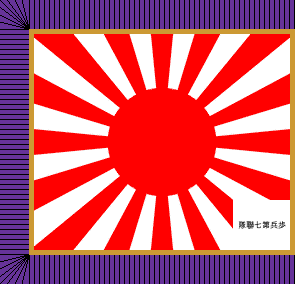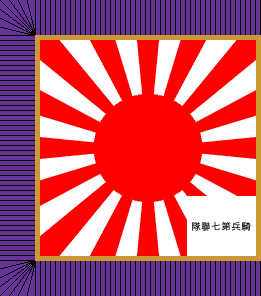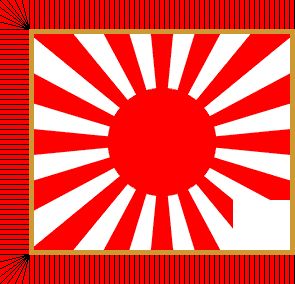![[Flag in decree 57, 1870]](../images/j/jp~1870.gif) image by Antonio Martins
image by Antonio Martins
Last modified: 2009-08-15 by phil nelson
Keywords: meiji era: japan | hinomaru | rising sun |
Links: FOTW homepage |
search |
disclaimer and copyright |
write us |
mirrors
See also:
1870 Merchant Ship's National Flag
![[Flag in decree 57, 1870]](../images/j/jp~1870.gif) image by Antonio Martins
image by Antonio Martins
Army National Flag
 image by Miles Li, 29 May 2008
image by Miles Li, 29 May 2008
In 1870 Daij˘-kan (the Great Council of State) made three separate promulgations regarding "national flag[s]".
So Japan of the early Meiji era ended up with four "national flags", with the army using the 16-ray "Rising Sun" some 20 years before the navy did; yet although the naval ensign at the time was the Hinomaru, it was technically a distinct flag from both the civil ensign and the naval jack!
Infantry Regimental Colour - 1879
 image by Miles Li, 21 September 2008
image by Miles Li, 21 September 2008
![]()
Infantry Regimental Colour - 1879
 image by Miles Li, 21 September 2008
image by Miles Li, 21 September 2008
![]()
1879: Daij˘-kan abolished the "Army National Flag" on December 2, in favour of the Infantry Regimental Colours and the Cavalry/Artillery Regimental Standards.
The Infantry Regimental Colour was 2 feet 6 1/4 inches by 3 feet in dimensions, whereas the Cavalry/Artillery Regimental Standard was 2 feet 1 inch by 2 feet 1 inch. Both were 16-ray "Rising Sun" flags with the sun disc at the centre, and a white panel at the lower hoist, 7 inches by 8 inches, bearing the name of the regiment in black kanji. There were gold edges on all four sides, plus purple (in practice a bluish purple) fringes on three sides and white sleeve at the hoist. Black flagpole with a finial displaying golden chrysanthemum (the Imperial Mon) on three facets.
It should be noted, however, that it took the Japanese some years to amalgamate their cavalry and artillery units into regiments. Regimental standards for artillery were abolished on January 10, 1885, without ever being presented, while the first regimental standard for cavalry was not presented until November 18, 1896.
Infantry Regimental Colour - 1879
 image by Miles Li, 31 May 2008
image by Miles Li, 31 May 2008
![]()
1885: On January 10 Daij˘-kan not only abolished the artillery regimental standards, but also instituted the Reserve Infantry Regimental Colours. These would have their fringes in red, but were otherwise identical to the purple-fringed (Regular) Infantry Regimental Colours. (jp^res.gif - note the reverse side is shown)
In interesting aspect of the Imperial Japanese Army was that they tended to take their regimental flags into battle, even during World War II. Sometimes these got damaged so much that only the poles, the finials and the fringes remained - an example, from the 57th Infantry Regiment, is on display in Yasukuni Shrine in Tokyo. Moreover, at the end of WWII the IJA was ordered to burn their regimental flags to prevent them from falling into the hands of the Allies. Only one complete flag, from the 321st Infantry Regiment, escaped annihilation, and is now also on display at Yasukuni Shrine.
Miles Li, 29-31 May 2008